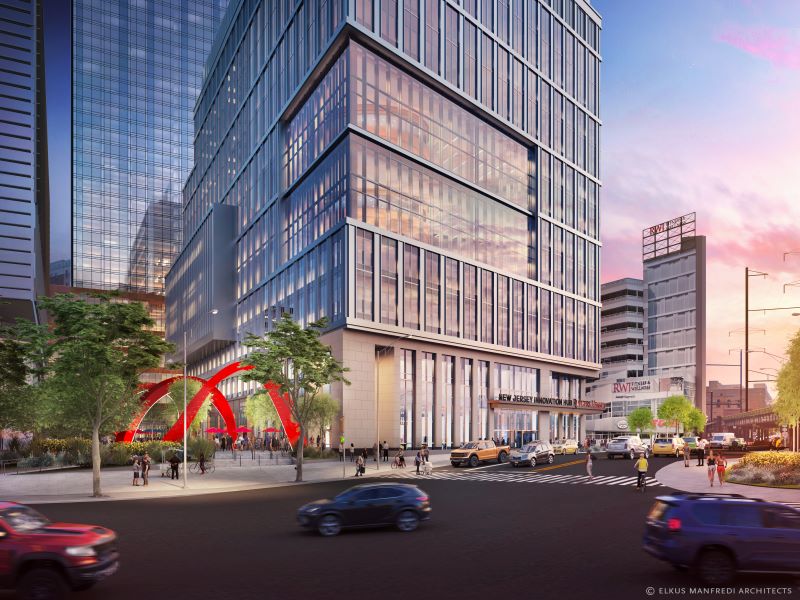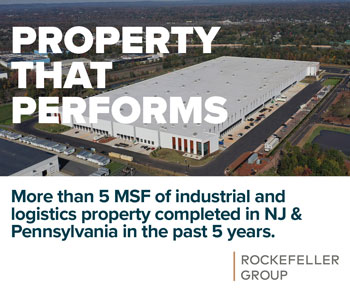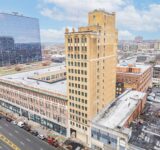New Brunswick Development Corp. and its construction partner, Jingoli, are set to top out the 12-story, 574,000-square-foot first phase of the HELIX project in New Brunswick, where plans call for an incubator known as the New Jersey Innovation HUB, the new home of Rutgers Robert Wood Johnson Medical School and a Rutgers translational research facility. — Courtesy: Devco
By Joshua Burd
The developer of the landmark HELIX project in New Brunswick will mark a key milestone on Friday when it tops out the first of three buildings at the campus, hoisting the final steel beam for the 12-story, 574,000-square-foot structure downtown.
For New Brunswick Development Corp., it’s also a chance to highlight what’s still to come at a facility that will be unlike anything else in New Jersey. The building known as H-1 will include not only new homes for both Rutgers Robert Wood Johnson Medical School and group of elite researchers from Rutgers University, but an incubator known as the New Jersey Innovation HUB that will cater to startups of all shapes and sizes, offering a mix of open lab systems and individual spaces ranging from around 1,500 square feet to so-called step-up labs of 4,000 to 5,000 square feet.
Notably, that design is meant to respond to changes in the marketplace.

“Originally, we were going to do all open labs, and when we first started this adventure, that’s what a lot of these incubators were doing,” said Chris Paladino, president of New Brunswick Development Corp., or Devco. “And now you’re starting to see more people want to be able to share equipment and have collaborative space, but also be able to lock the door to their laboratory.”
Years in the making, the $732 million building is on track to substantially completed by late 2025, Paladino said. That will allow Gov. Phil Murphy, who has championed the three-phase, 1.5 million-square-foot project officially known as the Health & Life Science Exchange, to cut the ribbon before his second term ends.
In the meantime, Devco will join its project team and other supporters on Friday for a topping out ceremony after having assembled nearly 5,200 pieces of steel and poured some 12,800 cubic yards of concrete. And the first 800 of what will be 3,000 exterior wall panels will begin arriving later this month to the site just south of Albany Street.

Paladino also notes that the work of minority- and women-owned subcontractors account for 34 percent of the overall project value, far exceeding the 24 percent goal set by Devco and its construction partner, Jingoli.
What comes next are several steps on a path that will lead to tenant move-ins starting in spring 2026, he said. That includes what’s known as a translational research facility for Rutgers, which will span nearly 250,000 square feet of high-end lab equipment and support space, providing a place for collaboration among scientists from varied backgrounds. That space is fully designed, as is the roughly 160,000-square-foot medical school that will allow the institution to relocate from Piscataway, welcoming its first class to the HELIX that summer.
Paladino also expects the first members of the New Jersey Innovation HUB to arrive in the first quarter of 2026. Expected occupants include the state’s Economic Development Authority, RWJBarnabas Health, Hackensack Meridian Health, Middlesex County and Rutgers, which will help populate nearly 70,000 square feet of anchor tenant space.
Devco will have other priorities in the near term, Paladino said. They include choosing an operational partner for the Innovation HUB’s lab and startup space, he said, noting that it will likely come from a pool of candidates that have managed similar facilities in places like New York, Boston, Philadelphia and Silicon Valley, to name a few.
 He expects the organization to make a pick by the end of this year, he said. And Devco hopes to have at least one key member of that team in place by early 2025, allowing them to “do some basic networking activity” to begin marketing the HUB’s incubator and research space, while ensuring would-be users are aware of the timeline.
He expects the organization to make a pick by the end of this year, he said. And Devco hopes to have at least one key member of that team in place by early 2025, allowing them to “do some basic networking activity” to begin marketing the HUB’s incubator and research space, while ensuring would-be users are aware of the timeline.
That’s critical for startups, Paladino noted, because “when they need space, they need space. They want to move in two weeks from now.”
Design-wise, the Innovation HUB will have standard features such as lab benches, ventilation and fume hoods, largely following the look of Rutgers’ translational research space.
“Where the real rubber hits the road is the equipment that you have available for people to use,” Paladino said. “So we’re basically tracking a lot of the equipment that Rutgers will be buying … which is good because, when somebody from Rutgers has to leave the academic space and step up and basically start their company, we’ve got a lot of the same equipment.”
He added that the operator will also be able to provide more specialized equipment, noting that, “as people come in and there’s demand for different type of microscope, a different type of freezer, et cetera, we have some resources to be able to buy those things.”
That all means that, in less than two years from now, New Brunswick will see an infusion of new skilled scientists, professionals, entrepreneurs and others who will populate H-1. Consider that Rutgers plans to recruit 80 new principal investigators for its translational research facility, each of which figures to have a team of six to 10 people, meaning the arrival of potentially hundreds of new occupants by the time the facility is fully functioning.
That’s not to mention the startups that will occupy the Innovation HUB. There’s also the roughly 1,000 employees of Nokia’s iconic Bell Labs division that will relocate to phase two of the HELIX from Murray Hill, in a 360,000-square-foot lab and office tower by SJP Properties that could break ground by year-end and be open around 2028.
“They’re essentially moving a thousand physicists, computer scientists, mathematicians and electrical engineers to New Brunswick,” Paladino said, “and they’re going to be recruiting over the next seven years somewhere in the neighborhood of (another 500).”
Legacy moment: Inside the landmark deal to bring Nokia Bell Labs to New Brunswick’s HELIX campus









